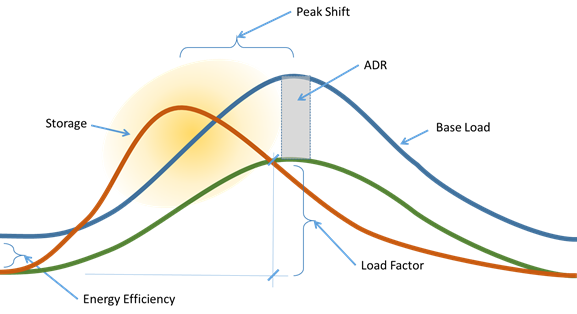As policy makers and the building community encourage improved building efficiency and reduced carbon impacts, the rapid proliferation of distributed renewable energy resources–on local businesses and homes–creates technical challenges for grid operation, even as traditional revenue models for utilities face significant uncertainty. In response to efficiency goals, the building industry is delivering more and more distributed energy generation onto the grid, with little or no regard for how the utilities must respond to the presence of these new distributed resources. To tackle this problem, New Buildings Institute (NBI) and the U.S. Green Building Council (USGBC) have launched a new initiative including a coalition of major electric utilities and other organizations that are committed to developing strategies and metrics to better integrate building loads and operating characteristics into utility grid management strategies.
makers and the building community encourage improved building efficiency and reduced carbon impacts, the rapid proliferation of distributed renewable energy resources–on local businesses and homes–creates technical challenges for grid operation, even as traditional revenue models for utilities face significant uncertainty. In response to efficiency goals, the building industry is delivering more and more distributed energy generation onto the grid, with little or no regard for how the utilities must respond to the presence of these new distributed resources. To tackle this problem, New Buildings Institute (NBI) and the U.S. Green Building Council (USGBC) have launched a new initiative including a coalition of major electric utilities and other organizations that are committed to developing strategies and metrics to better integrate building loads and operating characteristics into utility grid management strategies.
This project, called the GridOptimal™ Buildings Initiative, will develop a metric by which building features and operating characteristics that support more effective grid operation can be measured and quantified. The resulting rating system can be identified by designers and incentivized by utilities. By supporting the adoption of “GridOptimal” building features, utilities will be able to tap into a new resource to support grid services.
This effort comes at a critical time for the utility grid. In regions where significant renewable resources have been added, utilities are facing the need to deeply discount power prices or curtail renewable power resources at peak periods to maintain grid stability. Increased curtailment represents a significant reduction in the potential of renewable resources to reduce the carbon impacts of conventional grid operation. In regions with substantial renewable resources already online, some grid operators are forced to pay other regions to take their surplus power, periodically resulting in negative electricity prices in some regions! Increases in distributed solar resources are taxing older grid control systems as well.
Successful integration of these rapidly increasing distributed generation resources requires buildings themselves be able to more directly support grid operation by responding to fluctuations in grid load and contributing to broader efforts to manage more diverse grid resources.
To maintain dependability, utilities must continue to manage and support peak generating capacity, even as more and more utility generating resources may be forced to remain idle when distributed generating resources are feeding power to the grid. Successful integration of these rapidly increasing distributed generation resources requires buildings themselves be able to more directly support grid operation by responding to fluctuations in grid load and contributing to broader efforts to manage more diverse grid resources. While some building control features that allow short-term load response to grid peak are starting to be incorporated into buildings (demand management and response), there is a need for a more comprehensive approach to integrating building load management with grid operation. This is the goal of the GridOptimal Buildings Initiative.
This is the natural evolution of widespread energy efficiency incentive programs, since the new dynamics of grid operation require a focus on when buildings use energy, not just on how much energy they use. The opportunity exists to design buildings to routinely shift peak energy use and adjust loads to contribute to stable grid operations rather than to exacerbate grid shortages and oversupply.
The GridOptimal Buildings Initiative is working collaboratively with utilities, the building design and construction market, research labs and others to quantify the impact of passive and active building design strategies on hourly, daily, and annual building load profiles and to assess the opportunity to incorporate specific design features into buildings that allow these load profiles to be actively managed to support better grid operation.
How can buildings respond to grid operation?
The diagram below shows the different aspects of building response to grid conditions. In regions with automated demand response (ADR) already deployed as part of utility grid operation, buildings are incentivized to shed part of their load during peak demand conditions identified by the utility. In the GridOptimal Initiative, the types of building response to grid conditions would be significantly expanded.
Conventional Energy Efficiency, which lowers overall building energy use, still contributes to grid operation by reducing peak building loads. A focus on lowering the total peak load so that overall building loads are more flat (reducing Load Factor) also supports grid operation in most cases. This may be most valuable for its impact in reducing the building’s contribution to peak load. Another important strategy is to Shift Peak building load to a time that is not coincident with overall utility peak, especially if that coincides with the availability of solar photovoltaic (PV) generation.
A range of building design and operating strategies can contribute to active building load management. Thermal mass and night ventilation can pre-cool buildings to reduce and delay mid-day cooling loads. Fixed shading can reduce and alter the daily pattern of solar gain into the building. Occupancy sensors that reduce services to vacant spaces, and smart controls that schedule hot water, appliance, battery, and vehicle charging loads to coincide with utility surplus instead of peak periods can all improve the interaction between buildings and the grid.
By encouraging the deployment of these strategies, and quantifying their distribution and dispatch capability for utility managers, the GridOptimal Buildings Initiative can help buildings become a more integrated part of utility operation. This will allow the utility grid to make more effective use of the rapidly increasing renewable resources on the grid to effectively offset conventional fossil fuel generating resources.
By NBI Technical Director Mark Frankel, a leading advocate and technical expert in commercial building performance setting the vision for what’s next in building design practices and leading on market adoption strategies.

